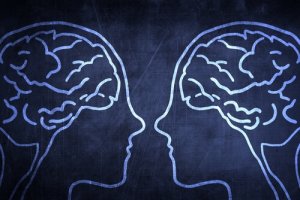Mirror Neurons and Empathy

Mirror neurons fire in the same way when you perform an action as when you observe someone else doing it. The fact that your brain has the same reaction in each situation explains learning through imitation, emulation, and even empathy. This is because you experience the other person’s action as your own, and it helps you to understand them.
The first time mirror neurons were discovered, it was in an experiment with animals, specifically monkeys. A study identified them for the first time in a species of macaque and located them in the premotor cortex, which specializes in planning, selecting, and executing movements.
After the discovery in monkeys, many different studies have been done on humans to find out if we also have mirror neurons, and if they’re related to learning, imitation, and empathy.
Putting yourself in the other person’s shoes
Humans can recognize other people’s gestures and identify their emotions just by looking at their face. Even if we don’t know the person, that doesn’t prevent us from guessing how they feel, and usually we’re right.

So when you see someone in a hurry, or someone falling down, you might feel their fear or pain as if it were your own. This transfer is completely innate. Having said that, we ask: which brain mechanism makes this possible? Everything points to mirror neurons and their connections to different areas of the brain.
Mirror neurons also have to do with how we interpret other people’s actions. Not only can they help us internalize and repeat an action that we just saw, they can also help us understand actions and make sense of them. They can help us understand why other people act the way they do and if they need our help.
When these specialized neurons are activated, other areas of the brain are also activated, such as the limbic system. We can recognize facial gestures by accessing our memories and things we’ve learned and combining all this information to interpret the situation and give it meaning.
“The minds of men are mirrors to one another.”
-David Hume-
Emotions are contagious
Humans are very impressionable. So much so that we can be affected by other people’s moods, producing a change in our own mood. When a coworker is sad and their face conveys this sadness, not only are we capable of understanding that something is wrong, but our mood might also be affected. Empathy not only lets us know what the other person is thinking, it also puts us in their shoes.
It’s also been proven that forcing a smile can make you feel better. Try it: one day when you feel depressed, laugh. The simple act of faking happiness will make you feel better. It’ll also help to be with a group of friends who won’t stop joking. Even if you’ve had a horrible day, their laughs will certainly be contagious.
Just like other people’s emotions can be contagious and have an effect on you, other people’s actions can also do this, especially at an early age. So exposure to violence in children through television can increase their level of violent behavior, because we tend to imitate what we see (keeping in mind that we’re not robots and we have the power to choose our own actions).
Get to know other people’s intentions
We’ve been imitating since we were young. First we imitated the gestures of our mothers, then we pretended to be doctors, chefs, police officers, etc. In adolescence, we had idols and people we wanted to emulate, and as adults, we emulate people who are successful.

Throughout our whole lives, we’ve imitated and put ourselves in other people’s shoes. We’ve even pretended to be people we weren’t. This is why film and theater exist; they come from our need to imitate and live in another reality.
Unlike the monkeys, who also have mirror neurons that are activated when they see another monkey performing an action, we are capable of interpreting whether someone is pretending, of knowing or guessing their intentions. Perhaps this is one of the characteristics that differentiates us from other species. We’re able to put a name to the person’s actions and make hypotheses about their intentions.
Mirror neurons can be activated by hearing, seeing, doing, or thinking about an action, but not all of these triggers will have the same impact. For example, we can recognize the situation better when we see it than when we hear it. In facts, humans work mostly with visual information, even though the rest of the senses are equally important.
The effects on our daily lives
The name of these neurons says a lot about what they are. The name suggests that they are activated when we see someone doing something. When this happens, it allows the brain to reflect the same pattern of activation as the person performing the action. In other words, to the brain, it’s like we’re doing the same thing the other person is doing. They function like a mirror.
We have the surprising, innate ability to identify small gestures that are difficult to fake. This is a good tool to know how the other person is feeling and how to treat them. It’s a very adaptive ability that helps us to interact and avoid problems.
This phenomenon was discovered not that long ago, and today they’re studying how they might be related to certain behaviors and illnesses. For example, low activity in these neurons has been detected in the brains of people with autism. So being able to study them is a ray of hope for understanding autism better and finding a treatment that improves the symptoms and adaptability of people with this diagnosis.
Mirror neurons fire in the same way when you perform an action as when you observe someone else doing it. The fact that your brain has the same reaction in each situation explains learning through imitation, emulation, and even empathy. This is because you experience the other person’s action as your own, and it helps you to understand them.
The first time mirror neurons were discovered, it was in an experiment with animals, specifically monkeys. A study identified them for the first time in a species of macaque and located them in the premotor cortex, which specializes in planning, selecting, and executing movements.
After the discovery in monkeys, many different studies have been done on humans to find out if we also have mirror neurons, and if they’re related to learning, imitation, and empathy.
Putting yourself in the other person’s shoes
Humans can recognize other people’s gestures and identify their emotions just by looking at their face. Even if we don’t know the person, that doesn’t prevent us from guessing how they feel, and usually we’re right.

So when you see someone in a hurry, or someone falling down, you might feel their fear or pain as if it were your own. This transfer is completely innate. Having said that, we ask: which brain mechanism makes this possible? Everything points to mirror neurons and their connections to different areas of the brain.
Mirror neurons also have to do with how we interpret other people’s actions. Not only can they help us internalize and repeat an action that we just saw, they can also help us understand actions and make sense of them. They can help us understand why other people act the way they do and if they need our help.
When these specialized neurons are activated, other areas of the brain are also activated, such as the limbic system. We can recognize facial gestures by accessing our memories and things we’ve learned and combining all this information to interpret the situation and give it meaning.
“The minds of men are mirrors to one another.”
-David Hume-
Emotions are contagious
Humans are very impressionable. So much so that we can be affected by other people’s moods, producing a change in our own mood. When a coworker is sad and their face conveys this sadness, not only are we capable of understanding that something is wrong, but our mood might also be affected. Empathy not only lets us know what the other person is thinking, it also puts us in their shoes.
It’s also been proven that forcing a smile can make you feel better. Try it: one day when you feel depressed, laugh. The simple act of faking happiness will make you feel better. It’ll also help to be with a group of friends who won’t stop joking. Even if you’ve had a horrible day, their laughs will certainly be contagious.
Just like other people’s emotions can be contagious and have an effect on you, other people’s actions can also do this, especially at an early age. So exposure to violence in children through television can increase their level of violent behavior, because we tend to imitate what we see (keeping in mind that we’re not robots and we have the power to choose our own actions).
Get to know other people’s intentions
We’ve been imitating since we were young. First we imitated the gestures of our mothers, then we pretended to be doctors, chefs, police officers, etc. In adolescence, we had idols and people we wanted to emulate, and as adults, we emulate people who are successful.

Throughout our whole lives, we’ve imitated and put ourselves in other people’s shoes. We’ve even pretended to be people we weren’t. This is why film and theater exist; they come from our need to imitate and live in another reality.
Unlike the monkeys, who also have mirror neurons that are activated when they see another monkey performing an action, we are capable of interpreting whether someone is pretending, of knowing or guessing their intentions. Perhaps this is one of the characteristics that differentiates us from other species. We’re able to put a name to the person’s actions and make hypotheses about their intentions.
Mirror neurons can be activated by hearing, seeing, doing, or thinking about an action, but not all of these triggers will have the same impact. For example, we can recognize the situation better when we see it than when we hear it. In facts, humans work mostly with visual information, even though the rest of the senses are equally important.
The effects on our daily lives
The name of these neurons says a lot about what they are. The name suggests that they are activated when we see someone doing something. When this happens, it allows the brain to reflect the same pattern of activation as the person performing the action. In other words, to the brain, it’s like we’re doing the same thing the other person is doing. They function like a mirror.
We have the surprising, innate ability to identify small gestures that are difficult to fake. This is a good tool to know how the other person is feeling and how to treat them. It’s a very adaptive ability that helps us to interact and avoid problems.
This phenomenon was discovered not that long ago, and today they’re studying how they might be related to certain behaviors and illnesses. For example, low activity in these neurons has been detected in the brains of people with autism. So being able to study them is a ray of hope for understanding autism better and finding a treatment that improves the symptoms and adaptability of people with this diagnosis.
This text is provided for informational purposes only and does not replace consultation with a professional. If in doubt, consult your specialist.







